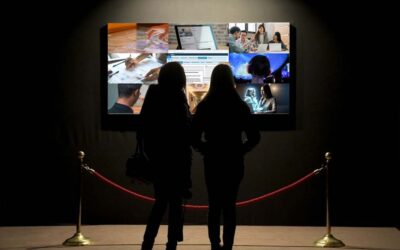Reimagining Museum Engagement for Younger Generations

Rachael Cristine Woody
Over the course of the next seven years the Smithsonian Institution’s National Air and Space Museum (NASM) will embark on a renovation of its original museum on the National Mall in Washington, D.C., to the tune of $1 billion dollars. NASM is reported to be the most visited museum in the United States and the 3rd most visited in the world, with 8.6 million visitors through their doors in 2017 and hundreds of thousands of digital visitors who frequent NASM’s website and collection search center.
When Forbes asked Dr. Ellen Stofan, the new head of the museum, what her foundation for the museum renovation was based on, she answered: middle school children. Dr. Stofan goes on to explain that middle school children have her focus because they are the ones who need to be inspired.
Focus on these young people, because they are the astronauts, astrophysicists, astronomers, engineers, computer scientists and other professionals and leaders of the future who will take American aerospace into the next 50 years and beyond.
Dr. Stofan further explains that for NASM, middle school age children are the largest age group represented in NASM’s visitor demographics.
While middle school children have NASM’s attention, Dr. Stofan and the team are also considering important focus questions, such as:
- What does the public want to know?
- What does the public need to know?
And just as important:
- How does NASM harness technology to “tell rich and impactful stories in new ways with an equal focus on the physical museum and online presence”?
These are questions that every museum should consider, regardless of whether they’re planning for a major renovation. Dr. Stofan’s focus on middle school children raises a significant and undeniable truth: younger demographics will soon (if they haven’t already) become prominent consumers of museum collections and will have an impact on the future of museums. Building museum engagement for younger generations involves realizing that these digital natives come with a different understanding of how one can interact with the world, and as a result, will have different expectations for how organizations such as museums should be responding. It is important that leaders have spent time considering how this generation interacts with information.
Improving Museum Engagement for Younger Generations: Needs of Digital Learners
In 2016, Lynda Kelly from the Australian National Maritime Museum presented nearly 20 years of museums audience research at Museums and the Web hosted in Los Angeles, California. While Kelly’s research is fairly broad and spans a large portion of time, she does dedicate a portion of her work to the evolution of the young museum visitor. In her 2009-dated work, she refers to the young visitors as “digital learners” who are “tech savvy”. From her results, we can observe how access to the internet has evolved their way of learning and perceive inherent truths as known by the young, digital learner. The digital learners museums will increasingly engage with have a new (to us) set of expectations:
- An ability to engage within the provided framework
- Instant access to answers and instant feedback
- Easy connections to other resources
- Social and collaborative learning opportunities
- No more “rote learning”
As articulated in Kelly’s 2013-dated work, when asked how young students view 21st century learning, responses indicated that critical thinking would become extremely important. Students “won’t be needed to solve maths [sic] problems anymore, but social subjects will become more important.” Museums of art, history, science, and culture can naturally lend themselves to social subjects, and can reimagine their collections and exhibits (digital and physical) with the aim of meeting the five expectations listed above.
Another marker of the digital learner is the undeniable and progressively seamless integration of technology into their lives. As Kelly concludes in her work: museums will need “to integrate learning and education in their (the youth’s) world, which is increasingly a technological one.” However, it’s not enough that objects be quickly digitized and thrown into an online gallery. Don’t forget the five expectations listed above! Ability to engage, access instant access to answers, make easy connections to other artifacts, tap into social and collaborative learning areas, and discovering a compelling story that offers critical thinking opportunities must be present in order to ensure museum engagement for younger generations and digital visitors.
Similar Posts
From Preservation to Resilience: An Introduction to Building Resilient Digital Collections
Preserving a digital collection is a job that is never done. But what if we shifted our focus from preservation to building digital resilience?
Client Spotlight: MacLaren Art Centre Goes Beyond Collections Care to Access and Growth
“As our needs evolved, it became clear that our existing CMS was no longer working for us. Not only do we need to perform basic collections care, we need a system that will support public access, enable growth, and match our innovative strategies.”
Museum Collections Online: Digital Storytelling Blog Series Roundup
An overview of 10 blog post series that highlight how museums can leverage online collections and digital storytelling platforms, strategies, tools, and best practices.
How Museums Can Broaden Access and Improve Accessibility with Digital Storytelling
Museum expert Rachael Cristine Woody explains how digital storytelling expands access and improves accessibility of museum collections with inclusive multimedia formats.




Leave a Comment
Comments are reviewed and must adhere to our comments policy.
0 Comments